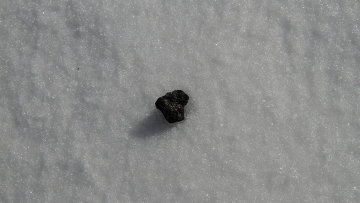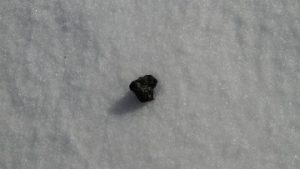
On February 15, a meteor came crashing into Russia’s Ural region, its shockwave causing damage throughout the area and bringing life to a screeching halt. One of the first priorities after caring for the injured was to find the meteorite. Lake Chebarkul was quickly fingered as a potential landing site due to a gaping 8 meter hole discovered in its iced-over surface.
On February 16, Interfax reported that meteorite hunting in the vicinity of Lake Chebarkul had been called off. It was thought that the massive hole in the lake’s surface ice must be due to causes other than Friday’s flaming meteor.
Just a day later, however, things were looking up for meteorite hunters. “We have just completed the study, we confirm that the particulate matters found by our expedition in the area of Lake Chebarkul indeed have meteorite nature,” said Viktor Grohovsky of the Urals Federal University and Russian Academy of Sciences according to RIA Novosti.
The discovery finally lends some certainty to prior estimates regarding the nature of the body that unexpectedly came crashing to Earth on the morning of February 15. Grohovsky confirmed that the meteorite is indeed a chondrite, as predicted by NASA experts. It contains about 10% iron. And what’s more, it may finally inspire an official name for what has so far been referred to as the Russian Meteor. “It is most likely to be named Chebarkul meteorite,” says Grohovsky. The official naming process will take two or three months, since a name is awarded by the International Meteoritical Society only after data about the rock is published in that organization’s bulletin.
The fragment found in Lake Chebarkul is thought to be one of seven large fragments from the parent meteor. There is no word yet as to recovery of the other fragments.
The initial announcement that no meteorite was been discovered in Lake Chebarkul had awakened conspiracy theories that Friday’s meteor was, in fact, a missile attack. While clearly untrue, at least one woman’s preparation for nuclear attack paid off. Fourth grade teacher Yulia Karbysheva is being lauded for saving all 44 of her students from injury by deploying a Cold War era strategy in which she had been well trained: she had all the students crouch under their desks for cover. When the classroom windows blew in, only Karbysheva, who was still standing, incurred injury; she suffered a severed tendon in her arm.
While expeditions continue to search for meteorite fragments, most of Chelyabinsk and its environs are putting themselves back together and resuming their normal routines. Worldwide, talk continues of what steps could and should be implemented to ensure that any future such event is adequately predicted.


















































































































![A trajectory analysis that used a computational fluid dynamics approach to determine the likely position and velocity histories of the foam (Credits: NASA Ref [1] p61).](http://www.spacesafetymagazine.com/wp-content/uploads/2014/05/fluid-dynamics-trajectory-analysis-50x50.jpg)



Leave a Reply